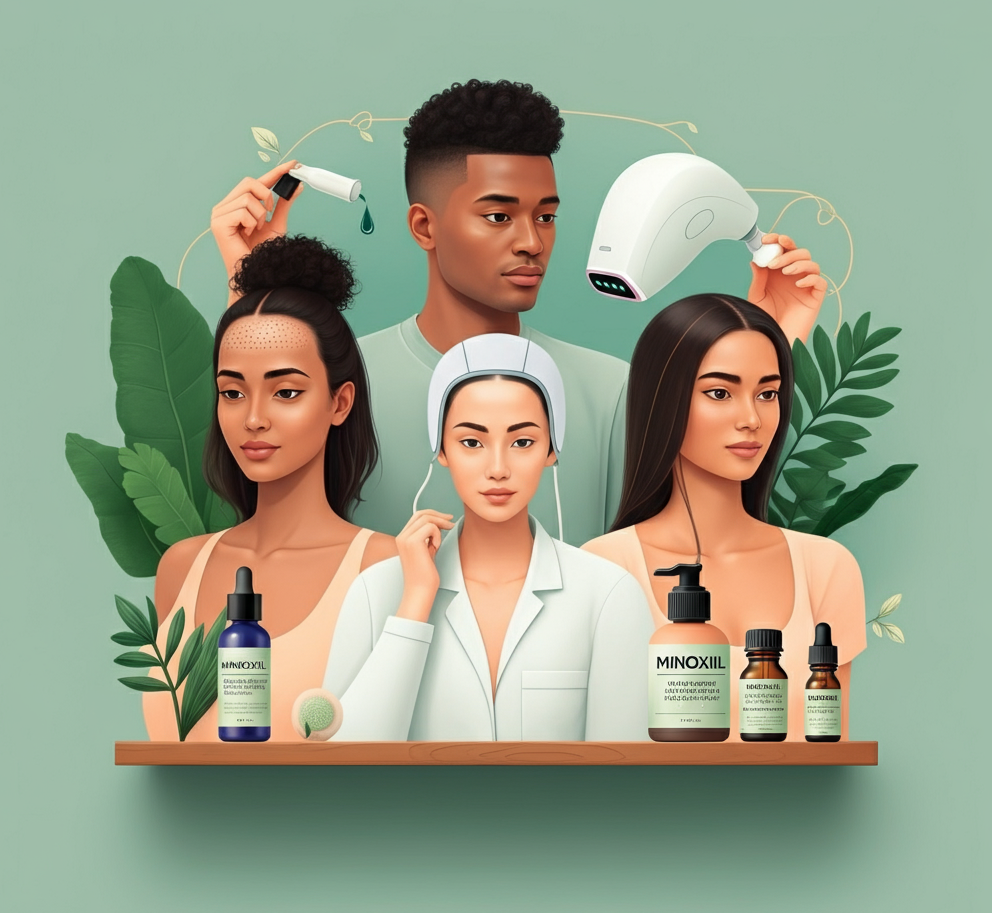
Hair loss can be a distressing experience for both men and women, significantly impacting confidence and overall self-esteem. According to the American Academy of Dermatology, approximately 80 million people in the United States alone suffer from hereditary hair loss. While surgical procedures like hair transplants are commonly sought-after solutions, they aren’t always a desirable or feasible option. Thankfully, there are effective non-surgical treatments available, offering innovative ways to combat hair loss, restore hair health, and regain confidence.
This guide explores the causes of hair loss and provides a detailed look at the most effective non-surgical treatments, natural remedies, and lifestyle changes to address this widespread concern.
Hair Loss:
What Causes Hair Loss?
Hair loss can occur for a variety of reasons, and understanding the root cause is essential for finding the right treatment. Some of the most common culprits include:
- Genetics (e.g., male or female pattern baldness caused by DHT sensitivity)
- Hormonal changes (e.g., pregnancy, menopause, or thyroid imbalances)
- Nutritional deficiencies (e.g., low levels of iron, zinc, or biotin)
- Stress (emotional or physical, such as major surgery or trauma)
- Hairstyling practices (e.g., excessive use of heat tools or tight hairstyles)
- Underlying medical conditions (e.g., alopecia areata, autoimmune diseases)
Types of Hair Loss
- Male/Female Pattern Baldness (Androgenic Alopecia): Progressive thinning or receding hair due to genetics.
- Alopecia Areata: Patchy hair loss caused by an autoimmune condition.
- Telogen Effluvium: Temporary hair shedding resulting from physical or emotional stress.
Why Early Intervention Matters
Early intervention can significantly slow or reverse hair loss progression. The sooner you act, the better the chances of preserving your hair. Don’t wait until the problem worsens – timely action can mean less invasive measures are required.
Topical Treatments for Hair Loss
Minoxidil
Minoxidil is an FDA-approved topical treatment available in liquid or foam form. It works by widening blood vessels, increasing scalp circulation, and revitalizing shrinking hair follicles.
- How it works: Stimulates the hair growth cycle and promotes thicker, healthier strands.
- How to use: Apply directly to the scalp once or twice daily.
- Expected outcomes: Noticeable results can take 3-6 months with consistent use.
Other Topical Solutions
- Caffeine-based serums to stimulate hair growth.
- Essential oils like rosemary oil for improved follicle health.
- Ketoconazole shampoos to reduce inflammation and strengthen the scalp.
Oral Medications and Supplements
Finasteride
Finasteride is a prescription oral medication designed to block the conversion of testosterone to DHT, a hormone responsible for hair follicle miniaturization in male pattern baldness.
- Who is it for? Exclusively for men.
- Side effects: Occasional reports of low libido; however, studies indicate these side effects are rare.
Supporting Supplements
The following can help address nutritional deficiencies linked to hair thinning:
- Biotin: Enhances keratin production.
- Iron: Supports oxygen transportation to hair follicles.
- Zinc and Collagen for stronger hair structure.
Laser Therapy (LLLT)
Low-level laser therapy (LLLT) is a painless and non-invasive treatment that uses red light to stimulate blood flow and hair follicle activity.
- How it works: The light wavelengths penetrate the scalp, encouraging cellular repair and new growth.
- Devices available:
-
- Laser caps (wearable, portable option)
- Laser combs or helmets
- Ease of use: Most devices require only a few 20-minute sessions per week.
Platelet-Rich Plasma (PRP) Therapy
PRP Therapy uses the patient’s own blood platelets to stimulate hair growth.
- How it works:
-
-
- A small amount of blood is drawn.
- Platelets are extracted and injected into thinning areas of the scalp.
- Growth factors repair follicles and improve hair density.
-
- Who’s it for? Ideal for all genders as a complementary procedure alongside other treatments.
- Benefits:
-
-
- Boosts follicle activity.
- Improves overall hair quality and thickness.
-
Microneedling for Hair Growth
Microneedling involves creating tiny punctures in the scalp using fine needles, encouraging the body’s natural healing response.
- How it works:
-
-
- Stimulates blood circulation and collagen production.
- Enhanced absorption of topical treatments like Minoxidil.
-
- Frequency:
-
-
- Typically performed once a month by professionals or using safe at-home dermarollers.
-
Natural Remedies
Home Remedies
- Aloe Vera:
-
-
- Reduces scalp inflammation and creates a healthy environment for growth.
-
- Coconut Oil:
-
-
- Nourishes the hair shaft and protects against protein loss.
-
- Rosemary Oil:
-
-
- Shown to improve blood circulation and boost hair density.
-
Balanced Diet for Hair Health
- Include foods rich in omega-3 fatty acids, antioxidants, and protein.
- Stay hydrated to maintain scalp health.
Customized Hair Replacement Solutions
For an instant aesthetic improvement, non-surgical hair replacement systems can provide a seamless and reliable option.
- Tailored to you:
-
-
- Matches your natural hair texture, color, and density.
- Offers a realistic, undetectable solution for patchy hair or thinning areas.
-
Combination Therapies for Optimal Results
Combining multiple treatments often yields the best results. For example:
- Pairing PRP with Minoxidil amplifies follicle activation.
- Using microneedling alongside topical serums boosts absorption and outcomes.
Consult with a hair specialist to design a targeted plan.
Lifestyle Adjustments to Support Hair Growth
Stress Management
Chronic stress can disrupt the hair growth cycle. Combat it with:
- Yoga or meditation.
- Regular physical activity.
Proper Hair Care
- Avoid tight hairstyles and excessive heat tools.
- Switch to sulfate-free shampoos to maintain scalp health.
Consulting a Professional
When dealing with persistent hair loss, consulting a trichologist or dermatologist is crucial to pinpoint the exact cause and develop a custom treatment plan.
- Seek assistance from trusted organizations like the International Society of Hair Restoration Surgery (ISHRS) for certified professionals.
Take Control of Hair Loss Today
Hair loss doesn’t have to be permanent. With advancements in non-surgical treatments, regaining confidence and restoring hair health is more accessible than ever. From topical solutions and PRP to lifestyle changes and natural remedies, there is a wide array of avenues to explore.
If you’re ready to take the next step, reach out to a qualified hair specialist. Personalized guidance and tailored treatments could be the key to unlocking your hair’s full potential.
Start your journey toward healthier, fuller hair today!







